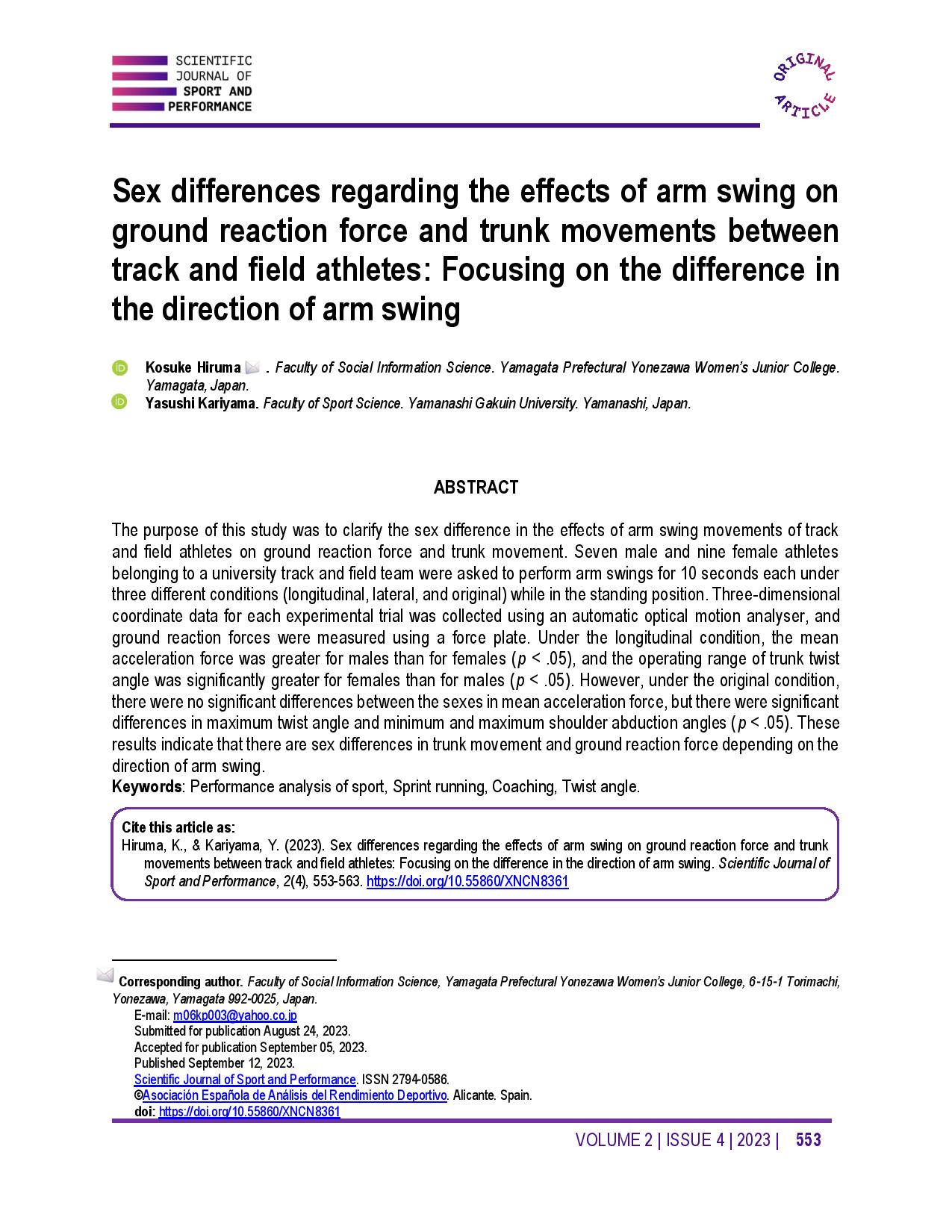Sex differences regarding the effects of arm swing on ground reaction force and trunk movements between track and field athletes Focusing on the difference in the direction of arm swing
Main Article Content
Abstract
The purpose of this study was to clarify the sex difference in the effects of arm swing movements of track and field athletes on ground reaction force and trunk movement. Seven male and nine female athletes belonging to a university track and field team were asked to perform arm swings for 10 seconds each under three different conditions (longitudinal, lateral, and original) while in the standing position. Three-dimensional coordinate data for each experimental trial was collected using an automatic optical motion analyser, and ground reaction forces were measured using a force plate. Under the longitudinal condition, the mean acceleration force was greater for males than for females (p < .05), and the operating range of trunk twist angle was significantly greater for females than for males (p < .05). However, under the original condition, there were no significant differences between the sexes in mean acceleration force, but there were significant differences in maximum twist angle and minimum and maximum shoulder abduction angles (p < .05). These results indicate that there are sex differences in trunk movement and ground reaction force depending on the direction of arm swing.
Article Details

This work is licensed under a Creative Commons Attribution-NonCommercial-ShareAlike 4.0 International License.
References
Abe, T., Kearns, C. F., & Fukunaga, T. (2003) Sex differences in whole body skeletal muscle mass measured by magnetic resonance imaging and its distribution in young Japanese adults. British Journal of Sports Medicine., 37 (5), 436-440. https://doi.org/10.1136/bjsm.37.5.436
Arellano, C.J., & Kram, R. (2011) The effects of step width and arm swing on energetic cost and lateral balance during running. Journal of Biomechanics, 44, 1291-1295. https://doi.org/10.1016/j.jbiomech.2011.01.002
Arellano, C.J., & Kram, R. (2014) The metabolic cost of human running: is swinging the arms worth it ?. Journal of Experimental Biology, 217, 2456-2461. https://doi.org/10.1242/jeb.100420
Bushnell, T., & Hunter, I. (2007) Differences in technique between sprinters and distance runners at equal and maximal speeds. Sports Biomechanics, 6, 261-268. https://doi.org/10.1080/14763140701489728
Bruening, D.A., Frimenko, R.E., Goodyear, C.D., Bowden, D.R., & Fullenkamp, A.M. (2015) Sex differences in whole body gait kinematics at preferred speeds. Gait posture., 41, 540-5. https://doi.org/10.1016/j.gaitpost.2014.12.011
Bruening, D.A., Baird, A.R., Weaver, K. J., & Rasmussen, A.T. (2020) Whole body kinematic sex differences persist across non-dimensional gait speeds. PLoS ONE, 15, e0237449. https://doi.org/10.1371/journal.pone.0237449
Brughelli, M., Cronin, J., & Chaouachi, A. (2011) Effects of running velocity on running kinetics and kinematics. Journal of Strength and Conditioning Research, 25, 933-939. https://doi.org/10.1519/JSC.0b013e3181c64308
Doolittle, D., & Tellez, T. (1984) Sprinting - from start to finish. Track Field Quarterly Review, 84, 5-8.
Gleadhill, S., & Nagahara, R. (2021) Kinetic and kinematic determinants of female sprint performance. Journal of Sports Sciences, 39, 609-617. https://doi.org/10.1080/02640414.2020.1837449
Hinrichs, R.N. (1987) Upper extremity function in running. II: Angular momentum considerations. International journal of sport biomechanics, 3, 242-263. https://doi.org/10.1123/ijsb.3.3.242
Hiruma, K., & Kariyama, Y. (2019) A cross-sectional study of the arm swing direction during sprint-running. Japan Journal of Physical Education, Health and Sport Sciences, 64 (2), 719-726. https://doi.org/10.5432/jjpehss.19005
Jacobs, C.A., Uhl, T.L., Mattacola, C.G., Shapiro, R., & Rayens, W.S. (2007) Hip abductor function and lower extremity landing kinematics: sex differences. Journal of Athletic Training, 42, 76-83.
Kariyama, Y., Hobara, H., & Zushi, K. (2018) The effect of increasing jump steps on stance leg joint kinetics in bounding. Sports Biomechanics,39 (3), 661-667. https://doi.org/10.1055/a-0633-9308
Kariyama, Y., Hobara, H., & Zushi, K. (2017) Differences in take-off leg kinetics between horizontal and vertical single-leg rebound jumps. Sports Biomechanics, 16 (2), 187-200. https://doi.org/10.1080/14763141.2016.1216160
Kreighbaum, E., & Barthels, K.M. (1985) Biomechanics: A qualitative approach for studying human movement (2nd ed). Burgess.
Liu, H., Leigh, S., & Yu, B. (2010) Sequences of upper and lower extremity motions in javelin throwing. Journal of Sports Sciences, 28 (13), 1459-1467. https://doi.org/10.1080/02640414.2010.514004
Mann, R., & Herman, J. (1985) Kinematic analysis of Olympic sprint performance: Men's 200 meters. Journal of Sport Biomechanics, 1 (2), 151-162. https://doi.org/10.1123/ijsb.1.2.151
McBride, J. M., & Nimphius, S. (2020) Biological system energy algorithm reflected in sub‐system joint work distribution movement strategies: influence of strength and eccentric loading. Scientific Reports, 10, 12052. https://doi.org/10.1038/s41598-020-68714-8
Nagahara, R., Matsubayashi, T., Matsuo, A., & Zushi, K. (2017) Kinematics of the thorax and pelvis during accelerated sprinting. Journal of Sports Medicine and Physical Fitness, 58 (9), 1253-1263. https://doi.org/10.23736/S0022-4707.17.07137-7
Nagahara, R., Kanehisa, H., Matsuo, A., & Fukunaga, T. (2021) Are peak ground reaction forces related to better sprint acceleration performance? Sports Biomechanics, 20 (3), 360-369. https://doi.org/10.1080/14763141.2018.1560494
Rabita, G., Dorel, S., Slawinski, J., Saez-de-Villarreal, E., Couturier, A., Samozino, P., & Morin, J.B. (2015) Sprint mechanics in world-class athletes: A new insight into the limits of human locomotion. Scandinavian Journal of Medicine & Science in Sports, 25 (5) , 583-594. https://doi.org/10.1111/sms.12389
Russell, K.A., Palmieri, R.M., Zinder, S.M., & Ingersoll, C.D. (2006) Sex differences in valgus knee angle during a single-leg drop jump. Journal of Athletic Training, 41 (2) , 166-171.
Sayers, M. Running techniques for field sport players. Sports Coach. 2000, 23, 26-27.
Takabayashi, T., Edama, M., Nakamura, M., Nakamura, E., Inai, T., & Kubo, M. (2017) Gender differences associated with rearfoot, midfoot, and forefoot kinematics during running. European Journal of Sport Science, 17 (10), 1289-96. https://doi.org/10.1080/17461391.2017.1382578
Tanner, J. M. (1951) Current advances in the study of physique. Photogrammetric an Androgyny scale. Lancet, 2658. 574-579. https://doi.org/10.1016/S0140-6736(51)92260-X
Tellez, T., Lewis, C., & Arellano, C.J. (2020) The Science of Speed The Art of the Sprint,; Winning Dimensions Sports: LLC.
Volkov, N.I., & Lapin,V.I. (1979) Analysis of the velocity curve in sprint running. Medicine and Science in Sports and Exercise, 11 (4), 332-337. https://doi.org/10.1249/00005768-197901140-00004
Wells , R.P., & Winter, D.A. (1980) Assessment of signal and noise in the kinematics of normal, pathological and sporting gaits. Human Locomotion, 1, 92-93.
Zeller, B. L., McCrory, J. L., Kibler, W. B., & Uhl, T. L. (2003) Differences in kinematics and electromyographic activity between men and women during the single-legged squat. American Journal of Sports Medicine, 31 (3), 449-456. https://doi.org/10.1177/03635465030310032101




